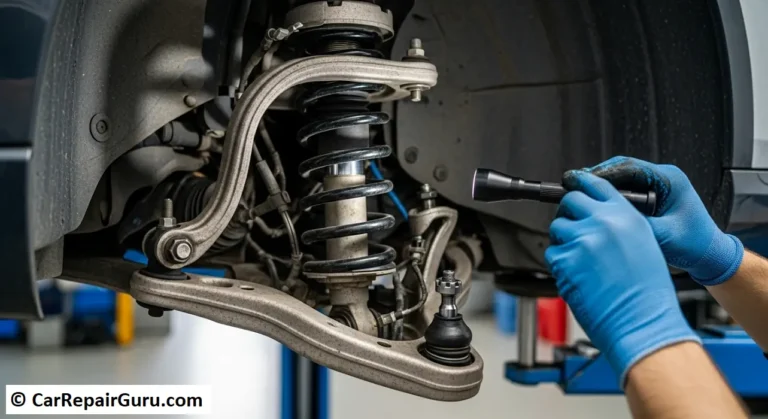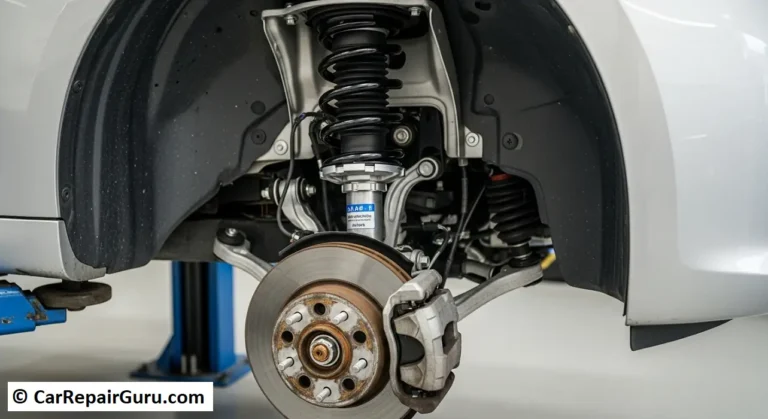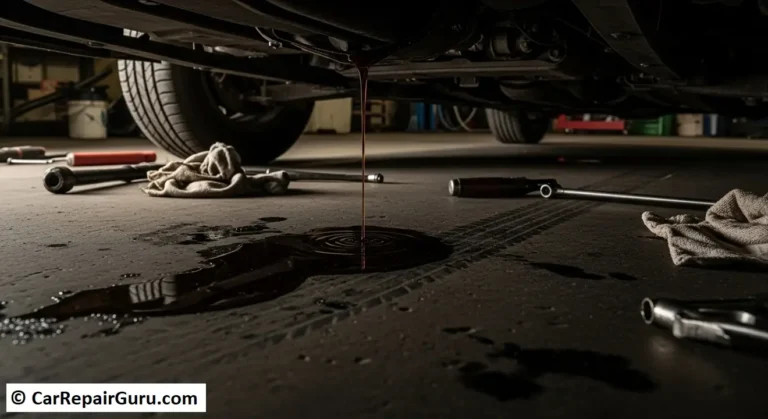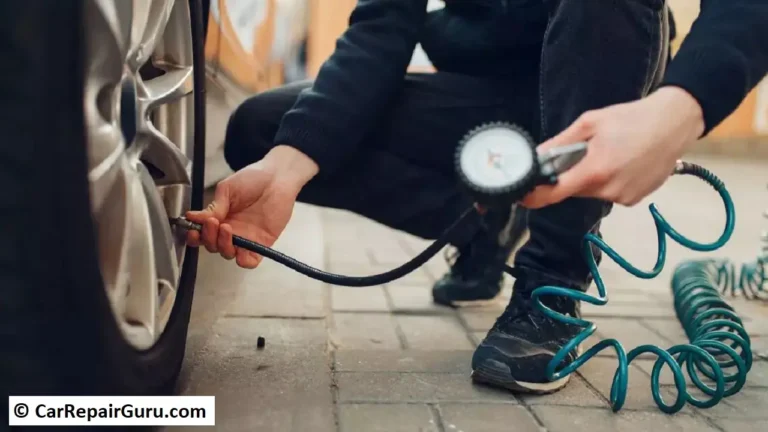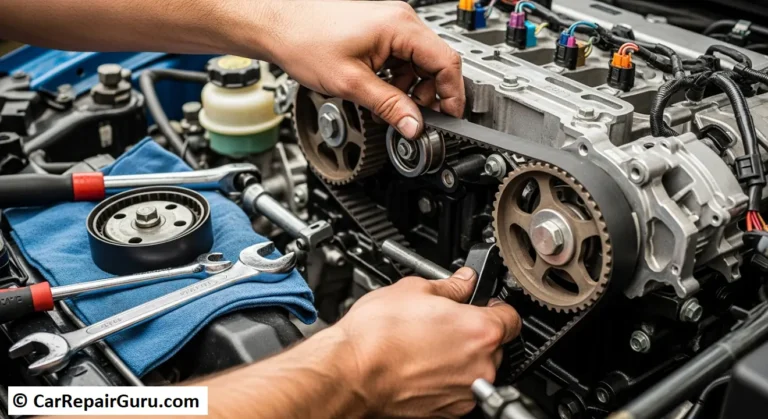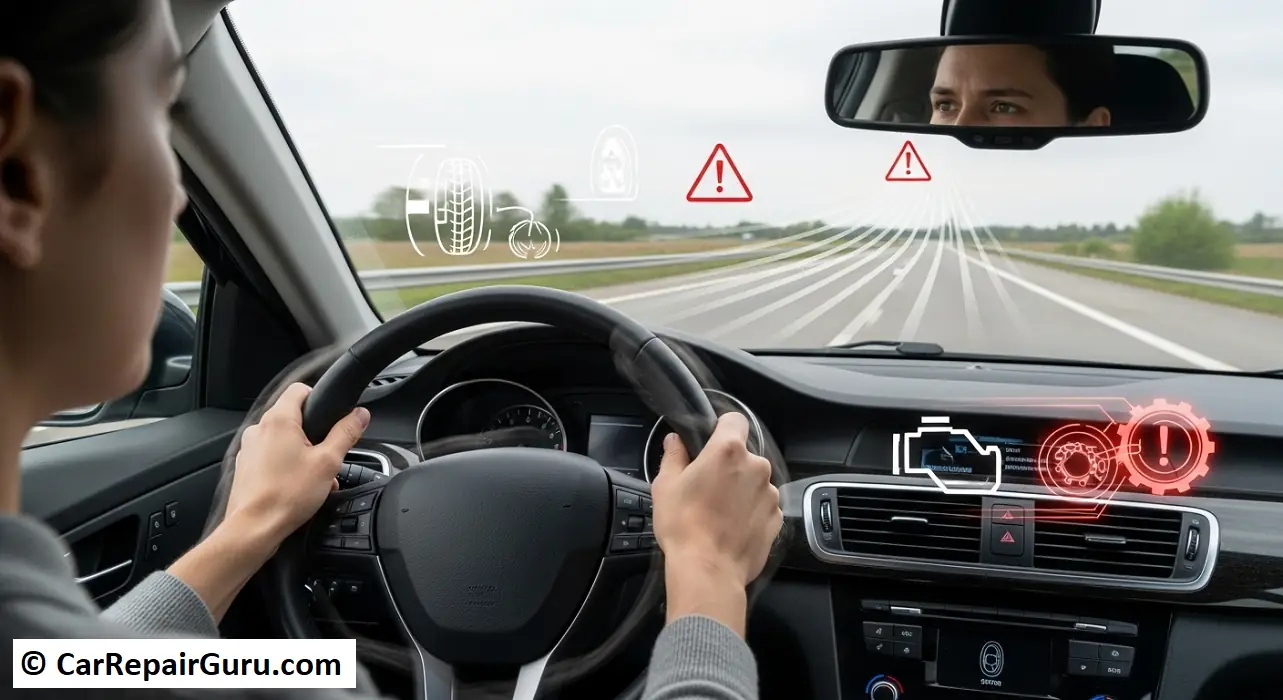
Is your car starting to feel… a little rebellious? A sudden shudder in the steering wheel on the highway, a new whining sound when you pull into a parking spot, or a constant fight to keep your car driving straight can be more than just annoying. It’s a direct message from your car that something is wrong.
Your car’s steering is its most fundamental safety system. When you experience steering issues, you’re dealing with a problem that directly impacts your control over the vehicle. Ignoring these symptoms isn’t just risky; it’s dangerous.
But don’t worry. This guide is here to help you become a more informed driver. We’ll walk you through how your steering system works, how to identify the 7 most common steering problems, understand their potential causes, and know when to call a professional. Let’s take back control.
Understanding Your Car’s Steering System: The Basics
Before we dive into the problems, let’s quickly cover how this critical system works. Think of your car steering as a team of components working together to turn your intention into the car’s action.
- The Steering Wheel & Column: This is your input—the captain of the ship.
- The Steering Rack & Pinion (or Gearbox): This is the brilliant translator. It converts the rotational motion of you turning the wheel into the linear (side-to-side) motion needed to turn the wheels.
- The Tie Rods: These are the crucial messengers, connecting the steering rack to the wheel knuckles and pushing or pulling them to change direction.
- The Power Steering System: This is the muscle. It provides the assistance that makes turning the wheel feel effortless instead of like an arm-wrestling match.
Hydraulic vs. Electric Power Steering (EPS): What’s the Difference?
The “muscle” of your power steering comes in two main flavors:
- Hydraulic Power Steering (HPS): The classic system. It uses a belt-driven pump to pressurize a special fluid (power steering fluid). This high-pressure fluid does the heavy lifting when you turn. This is the system most associated with power steering problems like fluid leaks and whining noises.
- Electric Power Steering (EPS): The modern standard. Instead of a pump and fluid, EPS uses a small electric motor to provide steering assistance. It’s more fuel-efficient and has fewer parts. When something goes wrong here, you’re more likely to see an “EPS” warning light on your dashboard than a puddle under your car.
Don’t Ignore the Signs: 7 Common Steering Issue Symptoms
Your car is great at telling you when something is wrong—you just have to know the language. Here are the most common symptoms of steering trouble.
1. Steering Wheel is Hard to Turn (“Stiff Steering”)
You feel like you’re suddenly driving a tank. It takes a surprising amount of muscle to turn the wheel, especially at low speeds or when the car is stationary. This is a classic sign of a loss of power steering assist.
2. Shaking or Vibrating Steering Wheel
This is one of the most alarming steering issues. You feel a shudder, shake, or vibration directly through the steering wheel. It might only happen at certain speeds (like when your car vibrates at 60 mph) or it might be constant. This indicates something is either out of balance or worn out.
3. Car Pulls to One Side
You let go of the wheel on a flat, straight road, and the car immediately wants to drift into the next lane. A car pulling to the right or left means you’re constantly making small corrections just to drive straight, which is both tiring and unsafe.
4. Grinding, Whining, or Squealing Noises When Turning
Your car shouldn’t make new noises. A high-pitched power steering whine that gets louder as you turn the wheel, a metallic squeal, or a deep grinding sound are all audible cries for help from your steering system.
5. Loose or “Sloppy” Steering
Does it feel like there’s a dead zone when you turn the wheel? This is known as loose steering or “steering play.” There’s a noticeable delay between when you start turning the wheel and when the car actually starts to change direction. It can make the car feel floaty and unresponsive.
6. Fluid Leaks Under the Car
If you have a hydraulic system, a puddle of reddish or pinkish-brown fluid under the front of your car is a dead giveaway of a power steering fluid leak. A leak means the system is losing pressure and will eventually fail.
7. Uneven Tire Wear
Take a look at your front tires. If the inside or outside edges are wearing down much faster than the center, it’s often a secondary symptom of a steering or alignment problem that has gone unaddressed for too long.
What’s Causing Your Steering Problem? Diagnosing the Root Cause
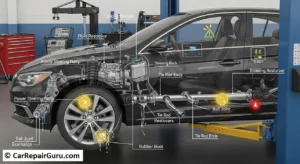
Now let’s connect those symptoms to the likely culprits.
Low or Contaminated Power Steering Fluid: This is the #1 cause of stiff steering and whining noises. Over time, fluid can leak out or become dirty and thick, losing its ability to work effectively.
Failing Power steering Pump: The heart of a hydraulic system. When it starts to fail, it can’t generate enough pressure, leading to a loud whine and steering that’s intermittently or permanently stiff.
Worn Tie Rod Ends: These are the small but mighty joints that connect your steering to your wheels. When they wear out, they become loose, causing sloppy steering, a clunking noise over bumps, and a shaking steering wheel.
Bad Wheel Alignment: This is the most common cause of a car pulling to one side and uneven tire wear. It’s not a broken part, but rather incorrect angles of your suspension geometry that need to be professionally adjusted.
Worn Ball Joints: These are the critical pivot points of your suspension. Worn ball joints can cause clunking noises and wandering, loose steering because the wheel assembly itself is no longer held tightly in place.
Damaged Steering Rack or Gearbox: This is the core component. A leak directly from the rack’s boots or a persistent grinding noise can signal a major failure. This repair is typically more complex and expensive.
The Critical Link: How Suspension and Tires Affect Your Steering
Your steering system doesn’t work in a vacuum. It’s intimately connected to your suspension and tires. Sometimes, what feels like a major steering problem is actually an issue with its teammates.
Tire Problems Disguised as Steering Issues
Before you assume the worst, check your tires.
- Unbalanced Tires: This is the most frequent cause of a steering wheel shaking at highway speeds (typically 55-70 mph). Small weights are attached to your wheels to ensure they spin smoothly; if one falls off, you’ll feel it.
- Improper Tire Pressure: A single underinflated tire can make your car pull to that side, mimicking a bad alignment.
- Tire Defects: A “radial pull,” caused by an internal defect in the tire’s construction, can create a persistent pull that even an alignment can’t fix.
Worn Suspension Components and Their Impact
Worn shocks, struts, or control arm bushings can cause the car to feel like it’s wandering or floating on the road, requiring constant steering corrections that feel like loose steering.
Steering System Repair: DIY Checks vs. Calling a Pro
So, you have a symptom. What can you do yourself?
Simple DIY Checks You Can Perform Safely
- Check Power Steering Fluid: For hydraulic systems, this is your first stop. Locate the reservoir (it often has a steering wheel icon on the cap), pull out the dipstick, and check the level. Note the fluid’s color—it should be clear red or pink, not brown or black.
- Check Tire Pressure: Use a simple tire gauge to ensure all your tires are inflated to the pressure recommended on the sticker inside your driver’s side door jamb.
When It’s Time to Call a Certified Mechanic
For your safety, anything beyond a fluid top-off or checking tire pressure should be handled by a professional. The steering system is complex and not forgiving of mistakes. You should always see a mechanic for:
- Diagnosing strange noises or vibrations.
- Any kind of part replacement (tie rods, ball joints, pump, rack).
- A wheel alignment.
How Much Does Steering Repair Cost? (An Estimate)
The cost to fix steering can vary dramatically. It depends on your car’s make and model, your location, and the specific part that has failed. Here are some general ballpark estimates to give you an idea.
Disclaimer: These are estimates for a typical sedan. Parts and labor costs can be higher for trucks, SUVs, and luxury vehicles.
| Repair / Service | Estimated Part Cost | Estimated Labor Cost | Total Estimated Cost |
|---|---|---|---|
| Power Steering Fluid Flush | $15 – $30 | $80 – $150 | $95 – $180 |
| Power Steering Pump Replacement | $150 – $500+ | $150 – $350 | $300 – $850+ |
| Tie Rod End Replacement (One) | $40 – $120 | $100 – $200 | $140 – $320 (Alignment extra) |
| Steering Rack Replacement | $400 – $1,200+ | $350 – $650 | $750 – $1,850+ |
| Four-Wheel Alignment | N/A | $90 – $200 | $90 – $200 |
Proactive Care: How to Maintain Your Steering System and Prevent Issues
The best repair is the one you never have to make. A little bit of proactive care can save you from major headaches and expensive steering issues down the road.
Regular Fluid Flushes
For hydraulic systems, don’t wait for the fluid to turn to sludge. Having your power steering fluid flushed every 50,000 miles (or as your owner’s manual recommends) keeps the system clean and lubricated.
Avoid “Dry Steering”
Try not to turn the steering wheel when the car is completely stationary. This puts maximum strain on the entire system. Even letting the car creep forward an inch or two makes a huge difference.
Get Regular Alignments
An alignment isn’t just for when your car is pulling. Get it checked once a year or anytime you get new tires. It’s the best way to prevent uneven tire wear and catch worn steering components early.
Steering Issues in Modern Cars: ADAS, Sensors, and Calibration
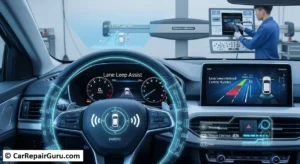
In newer cars, the steering system is also the brain behind safety features like Lane Keep Assist. This adds a new layer of complexity.
Is it a Problem or a Feature? If you feel your car gently “nudging” the wheel back towards the center of the lane, that’s likely the Lane Keep Assist feature working as designed. It can feel strange at first, but it’s not a sign of a car pulling to one side.
The Importance of Calibration: Many of these Advanced Driver-Assistance Systems (ADAS) rely on a steering angle sensor. After an alignment or the replacement of certain steering parts, this sensor must be recalibrated by a technician with the right equipment. If it’s not, your stability control and lane assist features may not work correctly.
Take Control of Your Vehicle’s Safety
Your vehicle’s steering system is your primary line of communication with the road. By learning to recognize the symptoms—from a vibrating wheel to a simple pull—you can catch problems early, before they become dangerous or lead to a cascade of expensive repairs.
Never put off a steering repair. Your safety, and the safety of everyone else on the road, depends on your ability to control your vehicle with confidence and precision.
Experiencing one of these steering issues? Don’t wait for it to get worse. Schedule an inspection with a certified technician today and ensure your car is safe, reliable, and ready for the road ahead.
Frequently Asked Questions About Steering Issues
Is it safe to drive with a steering problem?
No, driving with a steering problem is not safe. A failure can cause a sudden loss of vehicle control. Symptoms like loose steering, a shaking wheel, or a stiff wheel require immediate professional attention.
Can bad tires cause steering wheel shaking?
Yes, absolutely. Unbalanced tires are the most common cause of a steering wheel shaking, especially at highway speeds. Always have your tire balance checked first, as it’s a simple and inexpensive fix.
What’s the difference between a steering issue and an alignment issue?
A wheel alignment issue affects the car’s direction, causing a car to pull to one side. A mechanical steering issue (like a bad tie rod) causes physical sensations like noises, looseness, or a stiff steering feel.
Can I just add more power steering fluid if it’s low?
Adding fluid is only a temporary fix. Power steering is a sealed system, so if the fluid is low, you have a power steering fluid leak. The leak must be found and repaired to solve the root problem.
What does the EPS light on my dashboard mean?
The EPS (Electric Power Steering) light indicates a fault in the system. This usually disables power assist, making the steering wheel very hard to turn. The cause could be a failed sensor, motor, or wiring issue that requires a diagnostic scan.

